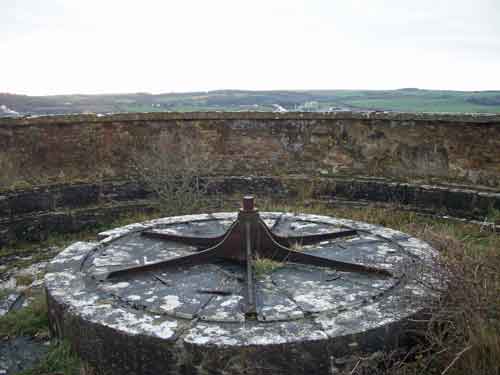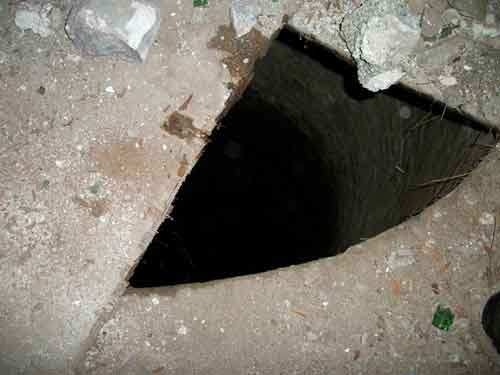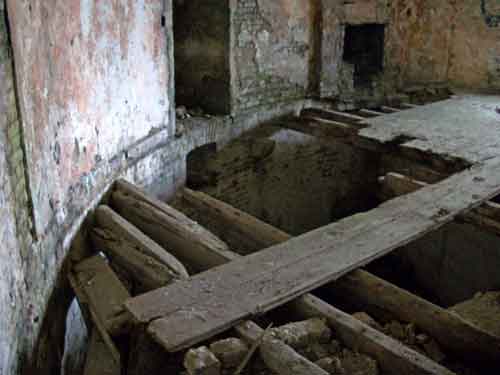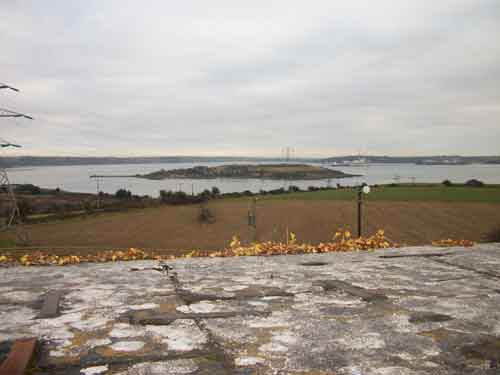
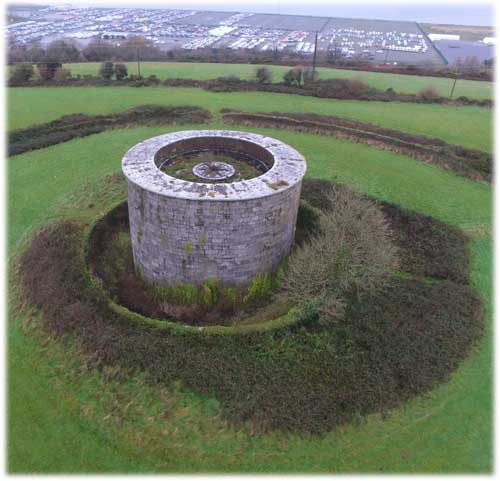
Ringaskiddy Martello Tower, the largest tower in Cork Harbour
The term Martello Tower is given to a type of defensive structure built during the Napoleonic era. These circular towers were designed to enhance existing fortifications, such as those in Cork Harbour. They were usually built to control areas where their field of fire could be directed at a constricted areas such as inlets and harbour mouths. There were approximately fifty of these towers built in Ireland, and 39 survive to this day.

Location of Martello Towers in Cork Harbour.
1. Monning (Fota). 2. Belvelly. 3. Rosslague.
4. Haulbowline. 5. Ringaskiddy.
The design of these towers varies from region to region, and date built. The Cork Harbour examples, are constructed of local limestone , with brick, internal construction. They are circular or elliptical towers, approximately 14 meters external diameter, with walls 2.5 meters thickness. The average height is 12 to 14 metres.
The ground floor was used for storage of supplies and arms, and had either a well, or cistern. the middle floor was used as living quarters. This was topped by a massive vaulted ceiling, which supported a flat limestone flagged roof on top. It was here that a traversing gun carriage supported a 24pdr or 36pdr, smooth bore, muzzle loaded gun. A central pivot supported the gun carriage, which ran on an iron rail fitted below the parapet.
The Cork Martello towers were each armed with 36pdr 56cwt gun. At the beginning of the 19th Century, these guns, over 9 feet long, were a formidable weapon, and were the standard armament of the ships of the line of the Royal Navy
An examination of the location of the Cork Martello towers reveals that four of these, Belvelly, Ringaskiddy, Rosslague, and Fota, were not designed for bombardment of attacking warships. They were placed to guard channels, most of which were shallow and tide-bound. The fear was that an attacking French force, would deploy longboats with marines, possibly guided by Irish sympathisers. These forces would be able to use the channels, such as that behind Great Island, to progress towards the city of Cork, about seven miles upriver. Instead of firing solid cannonballs (shot) , or fuzed explosive cannonballs (shell) these towerss had the option of firing canister shot, which would have decimated an attacking party of open boats.
The largest tower, in Ringaskiddy, would have had been of great use as a signal tower, as well as a gun platform,controlling the narrows between Spike Island, Rocky Island,and Ringaskiddy. It commands a 360 degree vantage of almost the entire harbour. The Haulbowline tower, was in direct line of sight of the Ringaskiddy tower, so as a communications tower, it would have been invaluable.
In time, the threat of French invasion passed, and the towers outlived their usefulness. Some such as Ringaskiddy and Fota, were in use during the Fenian Uprising, others were maintained by a caretaker. Military technology moved on, with the advent of rifled gun barrels and fuzed shells.
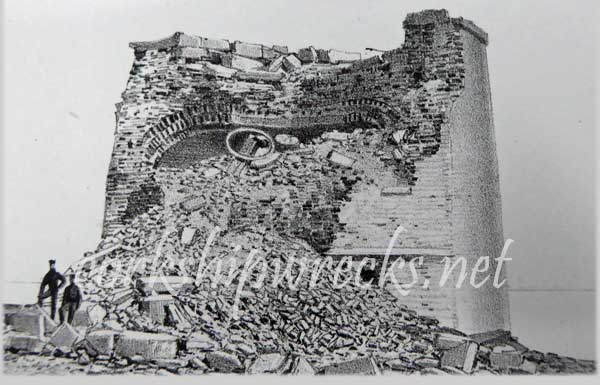
In 1860, artillery tests in England showed that these towers had outlived their usefulness
The walls of Martello towers were no longer impregnable, and they were particularly vulnerable to a shell from a howitzer or mortar on the flat roof. They were still useful as pillboxes and observation posts. Belvelly tower even had troops on duty there during World War One.
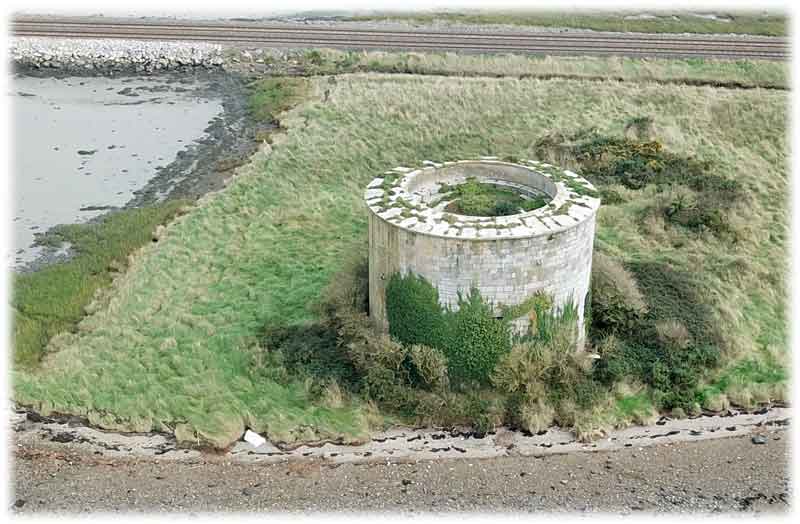
Fota (Monning) Tower
Fota Martello Tower
The site for this tower was chosen by Lieutenant Colonel W. Fenwick, Commanding Officer Royal Engineers, in April 1811. Construction was completed between 1813 and 1815. The tower was sited on a spit of land, known as either Monning, or Manning, depending on references. The location is north of Marino Point, where the Great Island north channel joins the main part of Cork Harbour.
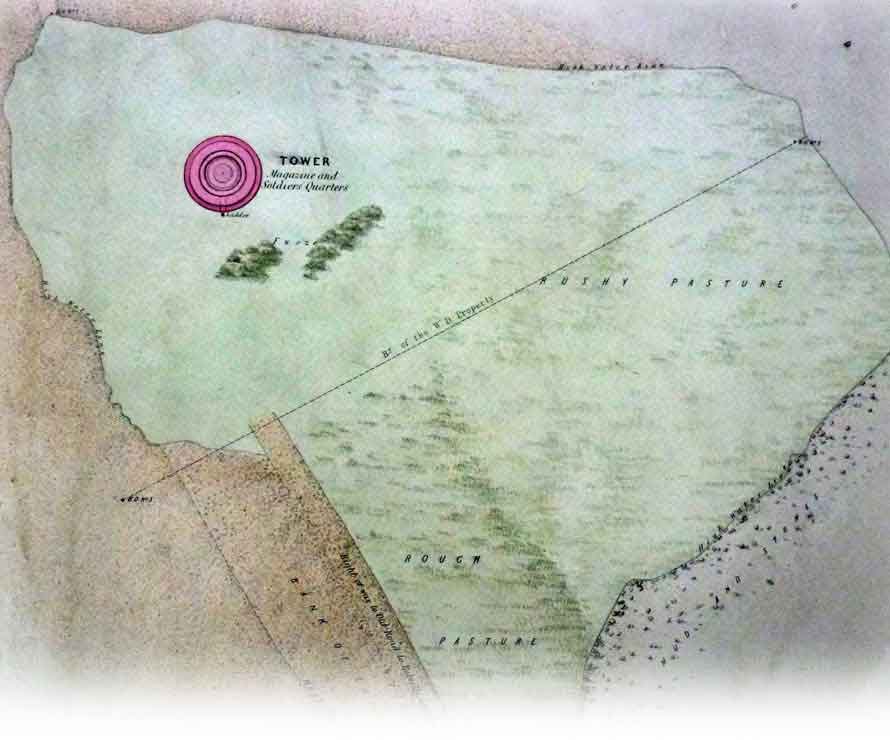
map showing position of Fota Tower
This Martello tower gained great notoriety in December 1867, when it became the only British Martello tower ever to be captured. On the the evening of the 26th of December 1867, the tower was manned by just two men, senior gunner Andrew Hickey, gunner John Radcliffe, and their wives and children. Radcliffe and his family were at tea when a man burst through the first floor entrance and put a revolver to his head. The raid, by five men was led by Irish-American William Lomasney, known among Fenians as Captain Mackey.
The gunners and their families were held hostage, while the gang removed 362 lbs of gunpowder, 22 8 lb cartridges, some bursting cartridges, and two carbines. The five made their escape, warning the gunners that they had left men in the grounds, who would shoot them if they attempted to leave. The gunners barricaded the door and attempted to signal distress by firing five shots from the roof mounted cannon. It was morning however, before help arrived.
Questions were raised, as to how the rebels had gained access to the 'impregnable' tower, with only a first floor entrance. It was common knowledge, however, that the ladders to these entrances, though supposed to be removed at night, never were. This made it easy, under cover of darkness, for the raiders to gain access. Senior gunner Hickey, was jailed for dereliction of duty, in not locking the door. Gunner Radcliffe, left the army shortly afterwards. The raid on this Martello tower, showed that in Ireland, at least, they were more of a liability than a military asset. A policy was begun of disarming the Irish Martello towers. The towers in Cork Harbour all had their cannon and ammunition removed by July 1868. A barge belonging to Cork Harbour Commissioners,was hired to transport the cannon back to Haulbowline.
Belvelly Martello Tower
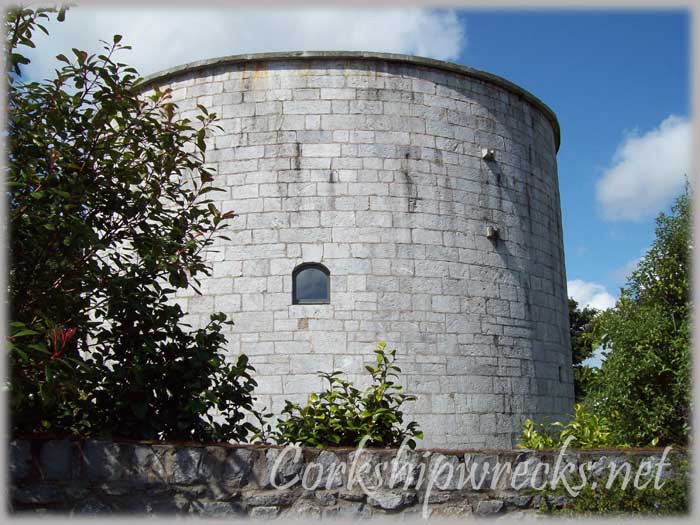
The site for Belvelly tower was chosen by Lieutenant Colonel W. Fenwick, Commanding Officer Royal Engineers, in April 1811. Construction was completed between 1813 and 1815. The tower is in a very strategic location, covering Belvelly bridge, on the north channel of Great Island. This is the only road bridge connecting it to the mainland via Fota. Previous to the bridge being built, this was the location of a ford for river crossing.
'The Battle of Belvelly Tower'
In April 1868, there was great apprehension of Fenian attacks, such as that, on the Fota (Monning tower). On the night of the 9th, the sentry on duty heard men approach the tower. He challenged the strangers but got no reply. A barrage of stones was launched against the tower breaking eight panes of glass. The gun crew fired four shots to signal for help, and the Queenstown police arrived . They found two off-duty gunners from the tower, lying unconcious on the ground outside The servicemen had arrived drunk, and were throwing stones to try to signal their comrades to gain access. The two gunners, James Dunne, and Thomas Carson,were court-martialled and jailed.
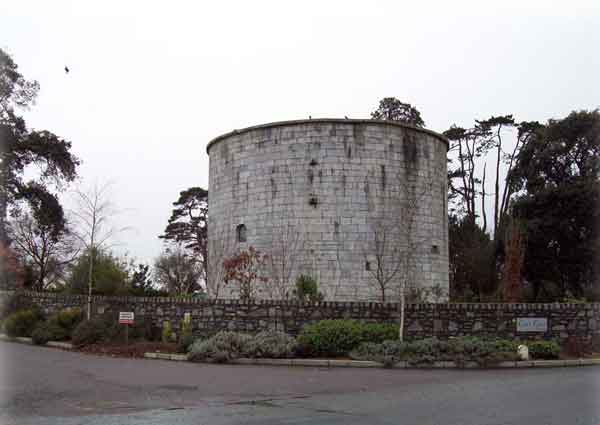
Belvelly Tower
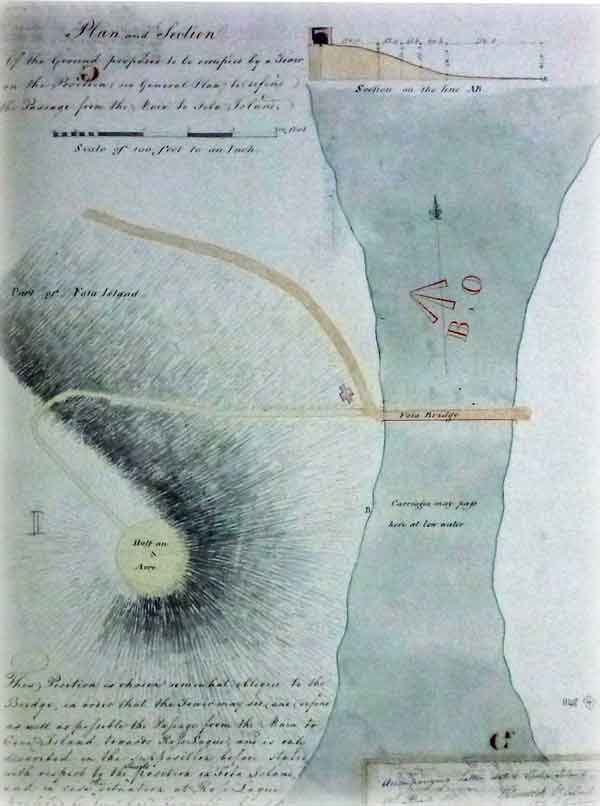
Map showing proposed position of Belvelly Tower
In the Summer of 1868 the cannon was removed from the rooftop and transported to Haulbowline on the Harbour Commissioners barge. The tower next saw use as a manned observation post during World War One. In 1922 the internals of the tower were partially demolished by explosives laid by the IRA. This would have been to prevent its use by the National Army. Belvelly tower languished, derelict, until sold in the mid 1980's. There were ambitious plans to convert the tower to a restaurant, but these did not progress.In 2006 the interior of Belvelly Martello Tower was completely rebuilt as a luxury home. It was last on the property market in 2011 with a guide price of €800,000.
Haulbowline Martello Tower
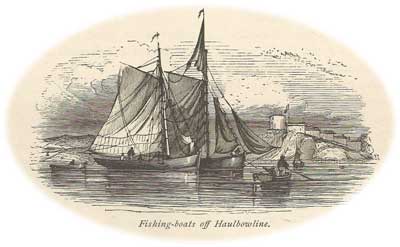
The Martello tower on Haulbowline Island was built between 1813 and 1815. It commands the narrowing river channel between the island and the Town of Cobh to the north.
As with the other towers in the harbour, by 1868, the tower was no longer viable as a gun platform, and the rooftop cannon was removed. In it's place, the British Admiralty installed a large iron water tank .

Haulbowline tower, with a Long Island Mackerel Yawl in foreground
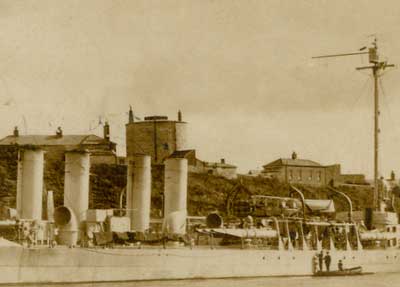
This 1918 view shows the water tank on top of the tower, with US destroyer USS Sampson in foreground.
This water tank did service, through the departure of British forces, and the formation of the irish Naval Service.
The tank was was finally removed in the mid - 1990's, when the Martello tower was converted to a museum. An 18lb cannon was installed on the roof, complete with traversing carriage. It remains there to this day
Rosslague Martello Tower

Rosslague Martello tower, detail from painting by John Bosanquet , View of the north coastline of Great Island.
The site for Rosslague tower was chosen by Lieutenant Colonel W. Fenwick, Commanding Officer Royal Engineers, in April 1811. Construction was completed between 1813 and 1815. Rosslague townland is referred to as Rossleague in some reports It is situated in the grounds of Rosslague House, on the north shore of Great Island, and has a commanding view of the north channel, eastwards towards Ballinacurra, and west to Belvelly. The limestone quarry from which the construction stone was used, is still visible.
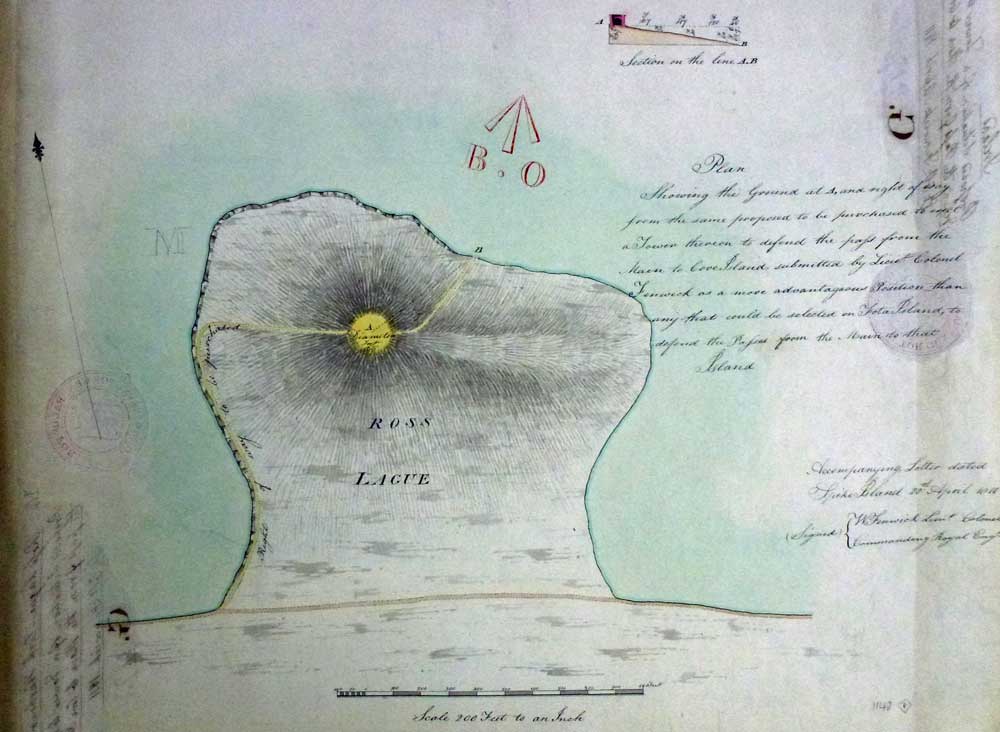
Royal Engineers map, showing position of Rosslague Tower
There is a very elaborate limekiln and storage building situated on the north shore below the Tower. As with the other Martello towers in Cork harbour, the rooftop cannon was removed in Summer 1868, and transported to Haulbowline on the Harbour Commissioners barge. At an unknown time a ground floor entrance was retro-fitted to the building.
Rosslague tower found a new lease of life in the twentieth Century, when used by the farm as a corn storage silo. The farm including tower was sold in 1927.

Rosslague Tower
In August 1952, there was a tragic accident in Rosslague tower. The owner, Patrick Collins was showing some friends around the tower. On the ground floor was the opening for the well, Mr Collins lost his footing and fell seventy feet into the well. He was recovered by Cork Fire Brigade, conscious, but died soon afterwards. The well opening was afterwards filled in with rubble, to prevent another tragedy occurring. In the 1970's Rosslague tower came into the possession of Cork County Council.
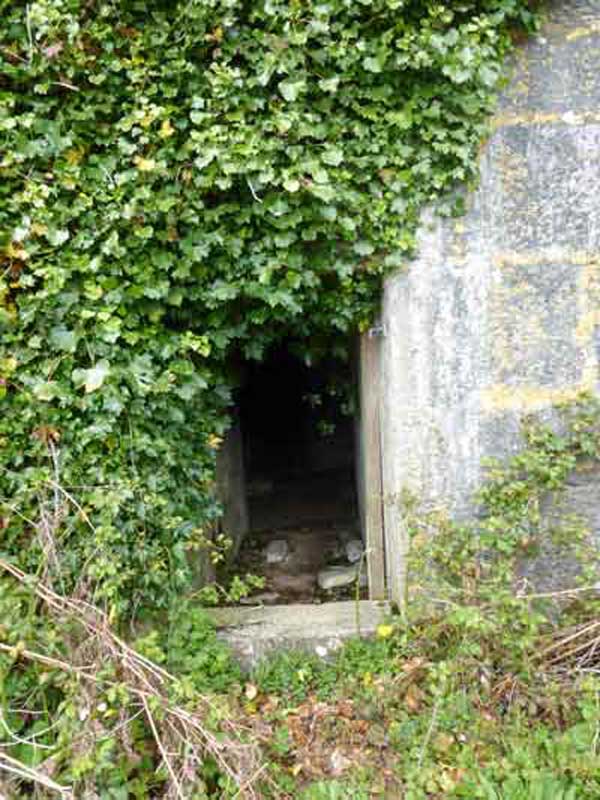
image showing retro-fitted ground floor entrance to Rosslague Tower
In the 1990's, there was limited remedial work done to the interior of the tower. Parts of the wooden internal floor were replaced, replacement window frames doorframes and doors were fitted. This remedial work appears to have been abandoned, unfinished. There had been a steel gateway fitted to the ground floor opening. This has now been ripped off. Vandalising of this monument is presently in progress.
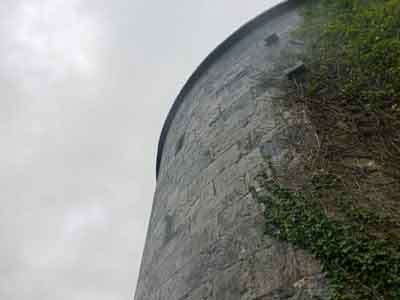
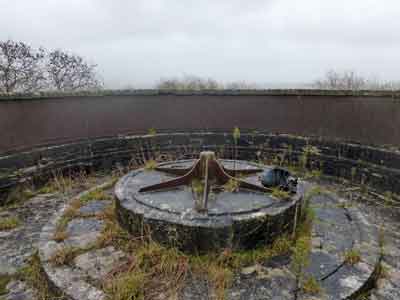
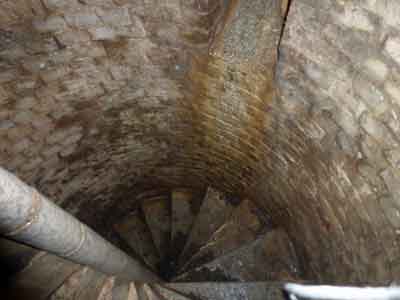
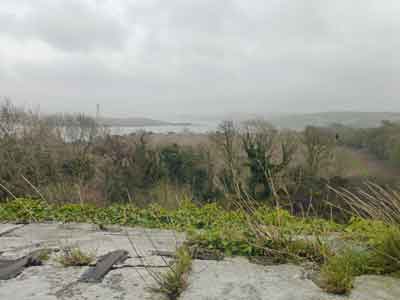
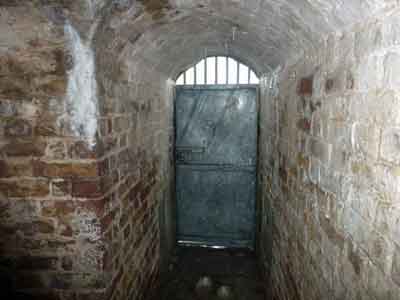
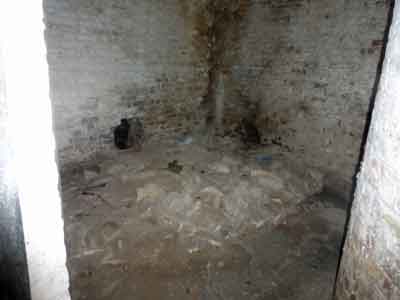
Ringaskiddy Martello Tower

The site for Ringaskiddy Martello tower was chosen by Lieutenant Colonel W. Fenwick, Commanding Officer Royal Engineers, in April 1811. Construction was completed between 1813 and 1815.
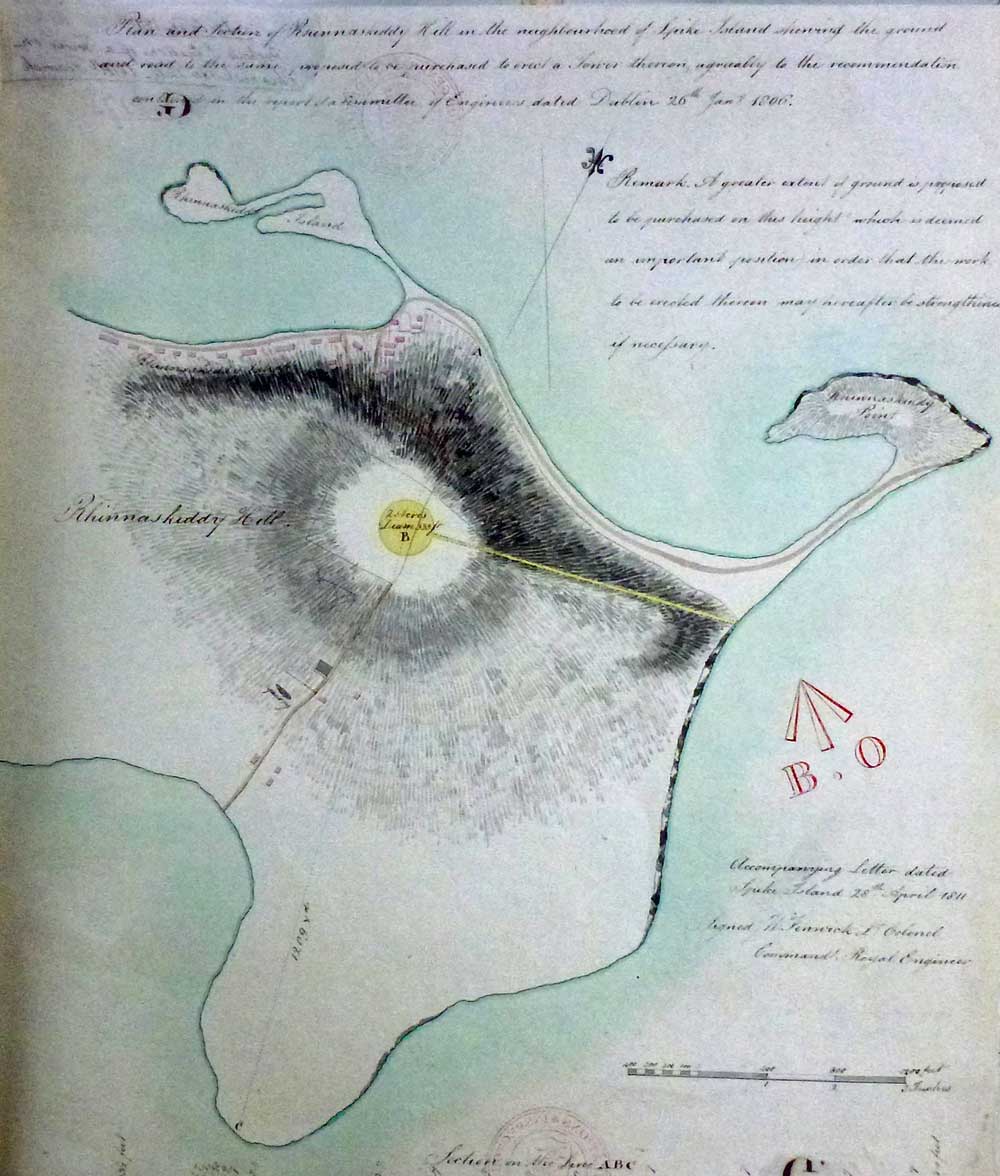
Map, circa 1811, of Ringaskiddy Tower
This Martello tower is the largest in Cork Harbour, Of eliptical shape, measuring 15 metres at the widest. It is unusual, in that it is a moated tower, with a fosse or ditch around it approx 3m in depth. The tower has commanding views of Cork Harbour and is in direct line of sight of Haulbowline Martello tower. Running outside of this is a rubble stone wall. This is not a defensive wall, and was probably intended to stop grazing animals from falling into the dry moat.
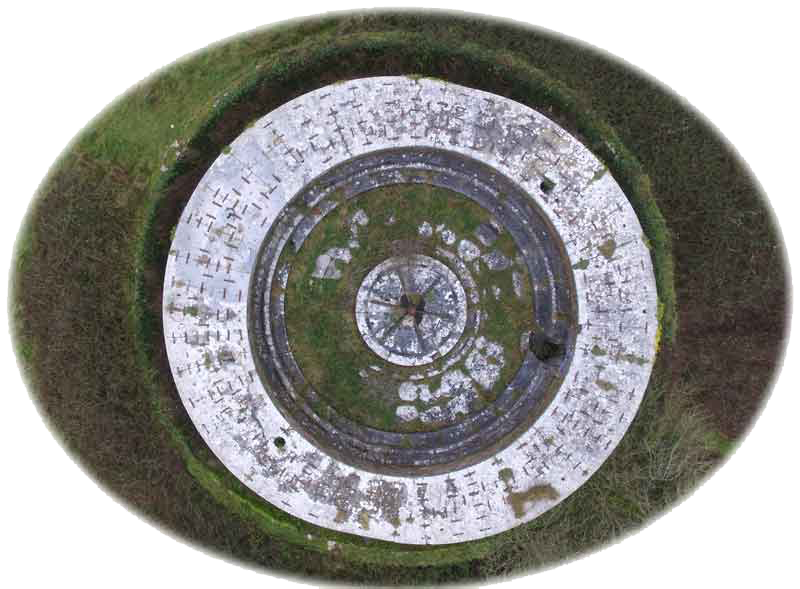
photo showing the elliptical shape of Ringaskiddy Tower
In common with the other towers, improvements in armaments meant that by the mid 1800s, the building was defunct as a gun tower. It was especially vulnerable on the roof section. Ringaskiddy tower was in use until 1868, when the rooftop cannon was removed, in common with the rest of the Cork harbour Martello towers.
The tower was was used as a private dwelling from the 1920's to the 1940's and it was probably at this time that the crude opening was made in the west wall. By the 1940s the building was held on a 99 year lease by a local farmer, but the structure itself, appears to have been derelict.By the 1970s, Ringaskiddy Martello tower, became part of the large land bank in the lower harbour area, held by the Irish IDA (Industrial Development Authority). There have been various plans since the early 1990s, to refurbish the tower as a tourist attraction,such as an industrial museum. None of these plans have progressed. In recent years some of the openings in the tower have been crudely cemented in. Overall the tower presents a forlorn neglected sight, surrounded by thick undergrowth.
